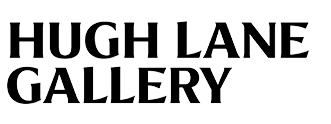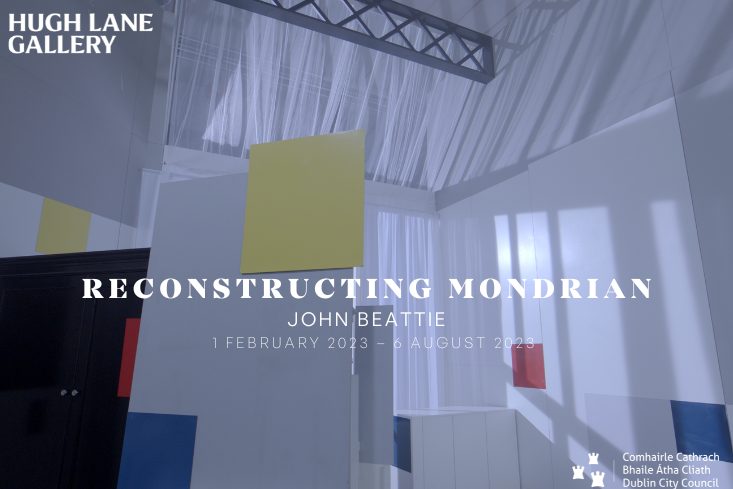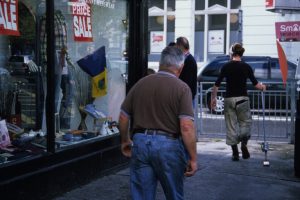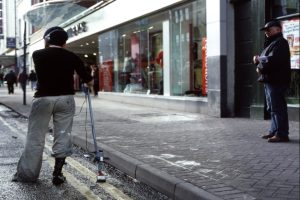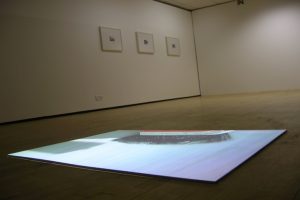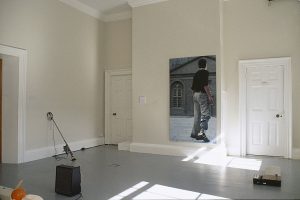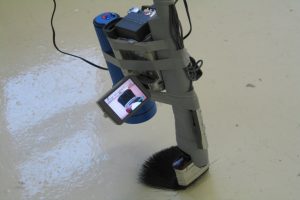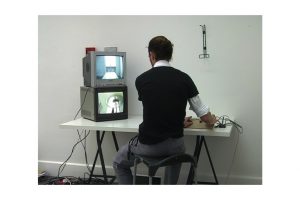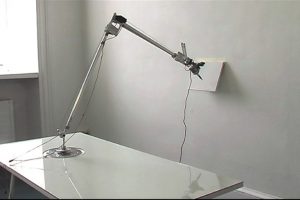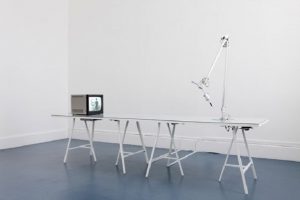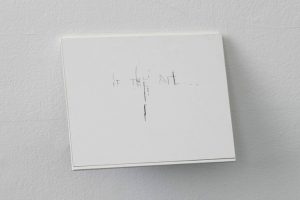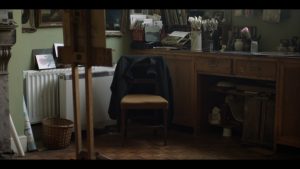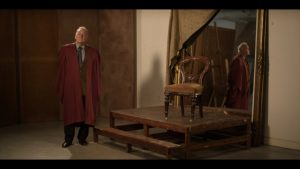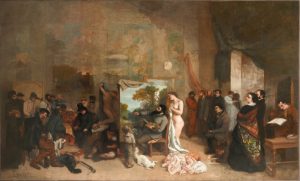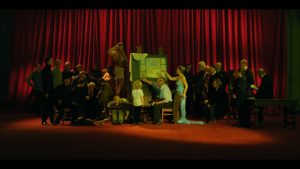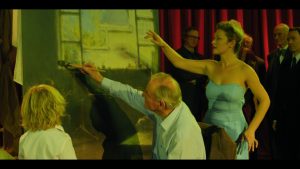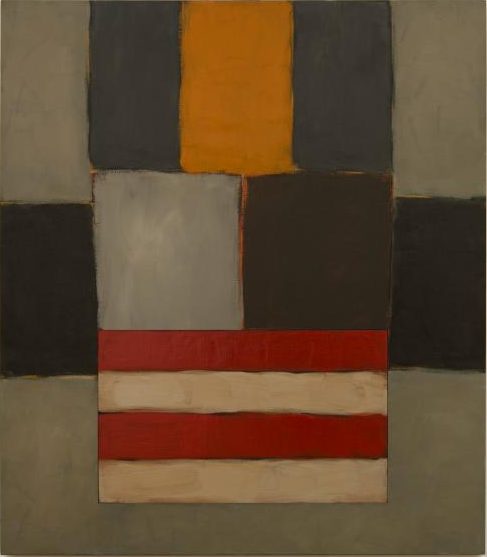Artists’ Takeover: John Beattie
Invited artists share ideas on their work and inspiration.
The Artist’s Studio:
To accompany the exhibition “Reconstructing Mondrian” at the Hugh Lane Gallery. An insight into John Beattie’s practice and research on the theme of the Artist’s Studio.
Introduction:
The history and image of the artist’s studio is the content I work with. I believe that we share a collective image of the artist and their studio and this is what I investigate in my practice. In “Reconstructing Mondrian” (2013-2022), at the Hugh Lane Gallery, this body of work deals with an architectural replica of Piet Mondrian’s original Paris studio from the 1920’s, by the Dutch architect Frans Postma.
As the Hugh Lane Gallery houses the permanent reconstruction of Francis Bacon’s studio, and has held extensive exhibitions on the theme of the studio, conceptually, it is significant that this work is exhibited and installed within this carefully considered context. The question which framed the making of “Reconstructing Mondrian” was: What is the function of this (Postma’s) studio reconstruction? A seemingly simple question, yet, there are many layers that can unfold with attempting to answer it. For “Reconstructing Mondrian” I undertook my reconstruction of this replica, to present new narratives and re-interpretations of this studio, using the medium of film and photography. The exhibition emerged from a large body of research and practice that I produced and directed over a 10 year period.
In addition, I will discuss here three bodies of previous work which demonstrate both experimental and choreographed methods of production and thorough research in the context of the artist’s studio, its collective image, re-interpretation, history and function.
-
Work 1 – “Extension Series” (2004-2010):
The title Extension Series alludes to the work’s intention, which sought to extend the traditional representation of the artist’s studio into an alternative space. It is the first artwork where I consciously experimented with the subject and the object of the artist’s studio.[1]

Fig no.1: Extension Series, 35mm colour slide film photograph, 2009 © John Beattie I describe Extension Series as a site-specific performance, which involved planned walks through public spaces. For these walks I wore my painterly studio attire – yes, I was once an actual painter in a traditional studio. I walked with a specifically assembled drawing tool that consisted of a video camera, an industrial painter’s brush, and a microphone, that was mounted to a painting extension pole. Take note of the video still below in fig 3: The lens of the video camera points to the ground, which frames the paintbrush head attached to the end of the painters extension pole.

Fig No.2: Extension Series, 35mm colour slide film photograph, 2005 © John Beattie 
Fig No.3: Extension Series, video still, 2006 © John Beattie When I walked with this drawing tool I followed the lines of pavements and shadows of architecture through specific locations. As I casually walked, the video camera recorded the lines and the movement of the paintbrush head gliding along the surface of the street. To capture this performative act of walking from an alternative perspective, I organised a photographer to follow my path, and document this process through 35mm colour slide film photography (fig no.1 and no.2). The photographs captured passers-by observing me at distance, the artist at work, as I navigated through public spaces. This was an important early studio experiment for the reason that the resulting photographs, and the video, developed my critical and conceptual thinking about staging the studio, this time, outside the frame of the traditional studio space. Extension Series became a way for me to invite a viewer/public into my process of working at the stage of the works production, as opposed to the works stage of exhibition. By extension, expanding the traditional studio space into this alternative place, and to make space for new interpretations.

Fig No.4: Extension Series, Installation at Letterkenny Arts Centre, Donegal, 2004 © John Beattie 
Fig No.5: Extension Series, Installation at the Irish Museum of Modern Art, for the group show Precaution, 2005 © John Beattie I then took elements from this process: the video, the photographs, the object, and considered how to position them in the gallery. The exhibition creates a dynamic between what is still (the photographs), what is moving (the video), and engaging with the work by interacting with the sculptural drawing tool. There are various ways to exhibit this body of work. At times, I project the video with the photographs. In other cases, I exhibit the sculptural drawing tool where the video plays back on the LCD screen on the video camera, and where the public can pick up the headphones, look, and listen to the video. The exhibited sculptural drawing tool embodied the entire process to represent the artist, the making of the work, and creates an alternative space to enter and engage with.

Fig No.6: Extension Series, Installation at the Irish Museum of Modern Art, for the group show Precaution, 2005 © John Beattie
-
Work 2 – “The Artist’s Studio Series (If the art…)” (2010-11):
Thematically, there are similar concepts at play in the work The Artist’s Studio Series (if the art),[1] created while I was Artist in Residence at the Irish Museum of Modern (IMMA) in 2010-11. As part of the residency programme, the artist is supplied with private accommodation and a separate studio.[2] Towards the end of the residency period, the artist is invited to exhibit work in progress in the museum’s “Process Room”. The studios are located across a courtyard adjacent to the museums Process Room. The studio does not come with resources or facilities other than the wonderful open-plan space itself. The studio is large, clean, and bright. Inside my studio was a table, chair, and a table lamp. I decided that these items would form the materials and tools to make The Artist’s Studio Series (if the art) – the studio, its contents, its location, and the frame of the Process Room museum exhibition space.
To begin, I fabricated the studio table lamp into a wirelessly controlled sculptural drawing tool. In collaboration with Dr. David McKeown, a mechanical engineer from UCD, he produced a digital code to effectively take control over the studio lamp. I refabricated the studio lamp with motors, sensors, a ball-point pen, and multiple live-fed cameras onto its body. This object was then positioned with the studio table in the process room exhibition space. In collaboration with Dr. McKeown, I developed a strategy to remain in my studio and, wirelessly control the re-fabricated lamp, and its parts, from 50 metres away. In my studio, I had full control over the movement of the lamps motors and lamp head. Using live-fed cameras and monitors, I was able to view the Process Room exhibition space, the perspective of the pens tip, and the re-fabricated lamp from my studio space.

Fig No.7: The Artist’s Studio Series (If the art…), video still, Artist Residency Programme at the Irish Museum of Modern Art, 2011 © John Beattie The objective was to inscribe a piece of text on a 10 inch x 12 inch canvas board, that was positioned on the Process Room wall, by using the wirelessly controlled apparatus from my studio, remotely. The partial piece of text that was inscribed onto the canvas board was sourced from one of Sol LeWitt’s sentences on Conceptual Art, which outlines:
If the Artist carries through his idea and makes it into visible form, then all the steps in the process are of importance. The idea itself, even if not made visual, is as much a work of art as any finished product. All intervening steps, scribbles, sketches, drawings, failed works, models, studies, thoughts, conversations, are of interest. Those that show the thought process of the artist are sometimes more interesting than the final product.” (Le Witt, 1969)

Fig No.8: The Artist’s Studio Series (If the art…), video still, Artist Residency Programme at the Irish Museum of Modern Art, 2011 © John Beattie Sol LeWitts’ sentence, for my work, continues to be one of value. [1] I place process in high regard, and pay particular attention to the planning and production processes. The resulting inscribed text on the canvas board spelled “if the art…” the beginning of Sol LeWitt’s statement. In a similar method to Extension Series, I assembled elements from the process and installed the work in the Process Room exhibition space. What was on display was a video playing on a CRT monitor showing the artist (me) at work in studio; the studio table and lamp; and the canvas-board drawing positioned on the wall where it was originally produced. For the exhibition, the displayed studio lamp was not still. It moved, rotated, it re-played the motion of drawing with it remotely. It re-enacted the drawing process.

Fig No.9: The Artist’s Studio Series (If the art…), Installation in the Process Room at the Irish Museum of Modern Art, 2011 © John Beattie Conceptually, the installation transferred the studio into the museum exhibition space. The installation simultaneously juxtaposes the site of production (the studio) and the frame of representation (the museum). As a result, creating a vibration between both sense of space and place. The installation appears simple, minimal. The process to make the work is deliberately complicated. The work invites the viewer to think about cultural labour, and the dissemination of cultural production, more broadly.

Fig No.10: The Artist’s Studio Series (If the art…), ball-point pen drawing on canvas board, the Process Room at the Irish Museum of Modern Art, 2011 © John Beattie
-
Work 3 – “An Artist, The Studio, and all the rest…” (2006-2012)

Fig No.11: An Artist, The Studio, and all the rest… Part 1, 4K colour video with 5.1 surround sound, duration 13mins, 2006-2012 © John Beattie An Artist, The Studio, and all the rest… takes the form of two cinematic 4K video projections with surround sound, produced and directed between 2006-2012. Part one portrays the bridging of a collaborative relationship I initiated with the Irish academic and traditional painter Thomas Ryan (PPRHA 1929-2021). When working with Ryan over those years, and for part one of this work, a cinematographer was directed to film our interactions and meetings in Ryan’s studio. To enter Ryan’s studio was like stepping back in time to the romantic periods of the 1900s. It was a special kind of place, and Ryan was a unique character. I’ll use this moment to thank Tom and the Ryan family for allowing me into his private and professional world. I used a cinema camera as a tool to capture moving images of the studio with a painterly aesthetic. This was achieved using slow tracking shots, in contrast with static shots, with staged and natural lighting, and qualities with mise-en-scene filmmaking. Additional locations where also filmed with Ryan at the Royal Hibernian Academy studio, in Dublin. The project was initiated in 2006, and part one portrays what became a “Master/Apprentice” relationship with Ryan during the course of this production. [1] It represents two opposite modes of artistic practises and worlds (traditional/contemporary) coming together to eventually, form and negotiate, a shared and equal space of understanding.

Fig No.12: An Artist, The Studio, and all the rest… Part 1, 4K colour video with 5.1 surround sound, duration 13mins, 2006-2012 © John Beattie In contrast, Part Two appropriates an historical painting by Gustav Courbet – The Painter’s Studio from 1854/1855.

Fig. No. 13: Gustave Courbet, The Painter’s Studio (1854-5), Musee d’Orsay Culturally, an iconic work by Courbet, with regards to the theme of the artist’s studio, and an important reference for my work to this day. Part Two is a staged and choreographed re-interpretation of Courbet’s painting, in a present time (2011). Filmed in The Great Hall at the Irish Museum of Modern Art, where I was very fortunate to acquire The Great Hall as the film set to re-stage this tableaux vivant.

Fig No.14: An Artist, The Studio, and all the rest… Part 2, 4K colour video with 5.1 surround sound, duration 16mins, 2006-2012 © The Arts Council of Ireland Collection To stand in for the characters depicted in Courbet’s original painting, I approached representatives from the contemporary and traditional visual arts scene, national cultural institutions, the Department of the Arts in Ireland, and a number of artists, writers, critics, and community activists to play their own present roles. My intention was to re-interpret Courbet’s studio and position my image of the studio in a contemporary context.[1] I describe part two as a representation of Irish Cultural Society, systems, and mechanisms. The work depicts individuals and representative bodies who also affected my career as an artist, and who impact the Visual Arts in Ireland. Ryan was positioned centrally in the image of the studio, to stand in the role as Courbet. This was a controversial and strategic decision to re-position Ryan, and what Ryan represents, alongside a contemporary visual art context. Fundamentally, the work functions to portray and stage the professional, personal, and private world of my artistic career within the frame of the studio. In 2012, I exhibited An Artist, The Studio, and all the rest… at the RHA, curated by Patrick Murphy.
An Artist, The Studio, and all the rest… represents the first time I worked with cinematic methods, and large-scale film crews. My role as the artist shifted to that of the producer and the director. I had to learn to wear many hats at once simultaneously. This is the reason why some of my works take a lot of time to realise from its planning, to production, to the exhibition. I am responsible for the entire process of the works realisation, including applying for the works financing. None of the above examples of work, or my current exhibition “Reconstructing Mondrian”, on view at the Hugh Lane Gallery, would have been possible to make without the support and funding from the Arts Council of Ireland. There are many individuals, peers, friends, family, and cultural institutions to thank.

Fig No.15: An Artist, The Studio, and all the rest… Part 2, 4K colour video with 5.1 surround sound, duration 16mins, 2006-2012 © The Arts Council of Ireland Collection To conclude, the above works embody my thinking and motivation, and provides you with a contextual background spanning two decades of my research on the subject of the artist’s studio. There is a lot more to be said and to be continued. This year, the Hugh Lane Gallery will publish my artist catalogue to accompany the exhibition “Reconstructing Mondrian”. The catalogue features an essay by Michael White, and by the Irish artist Gerard Byrne. It also includes an in-conversation between myself and Michael Dempsey – Head of Exhibitions at the Hugh Lane Gallery. During our conversation, Dempsey asked me a question with a reference to Daniel Burren’s essay on the Function of the Studio (1979), [1] and debates about the shift of the works location from the studio, to the frame of the museum institution, and if this shift of location ultimately changes the meaning of the studio. I end this article with my response to this question:
“In my work with the studio, I look to refresh such debates. The exhibition acknowledges the studios origins/authors, yet, sets the proposition for new meaning forward in motion (24 frames per second). In a present and contemporary climate, with regards to artists’, their studio’s, and the topic of its shift of location; the artists’ studio never seems stable”.
[1] See more about this work at: https://www.johnbeattie.ie/extension-series/
[2] See more about this work at: https://www.johnbeattie.ie/works/the-artist-studio-series/
[3] See more information about this project and residency: at https://imma.ie/whats-on/john-beattie-the-artists-studio-series/
[4] Le Witt, S. ‘Paragraphs on Conceptual Art’ first published in 0-9 ( New York ), 1969 and in Art-Language ( England ), 1969
[5] See part one video: https://www.johnbeattie.ie/works/an-artist-the-studio-and-all-the-rest/
[6] The cast in the scene for part two: Colm Toibin, Chris Flynn, Stephanie O’Callaghan, Rayne Booth, Rachael Gilbourne, Caoimhin Mac Giolla Leith, Eugene Downes, Stephen McKenna, Carey Clarke, Des Mac Mahon, Mick O’Dea, Amanda Coogan, Tom Ryan, Etain Nolan, Mary Begley, Marcin Wadowice, Noel Kelly, Mike Fitzpatrick, Ruairi O’Cuiv, David Trunk, Antoinette Emoe, Christian Reeves, Craig Starkey, Cillian Hayes, Michael Nolan, Bobbie Bryne, Mick Rafferty, Mark St. John Ellis and James Kelly.
[7] Burren’s essay ‘The Function of the Studio (1971)’ is included in this publication:
Hoffman, J. & Kennedy, C. “The Studio”, Dublin City Gallery, The Hugh Lane, 2006
-
About the Artist
John Beattie is a visual artist, originally from Co. Donegal and currently based in Dublin. He has exhibited widely nationally and internationally. Beattie has been awarded a number of residencies to date, including the Centre Culturel Irlandais, Paris, 2020; the apexart Fellowship, New York, 2015; IMMA, Dublin, 2011; Temple Bar Gallery & Studio, Dublin, 2010; the RHA, Dublin, 2010; and Fire Station Artists’ Studios, Dublin, 2006- 2009. Currently, he is artist in residence at the National Archives of Ireland as part of the State Decade of Centenaries Programme 2021-2023. Beattie’s work has been supported and funded by The Arts Council of Ireland through Visual Arts Project and Bursary Awards. His work is featured in State Collections such as The Arts Council of Ireland Collection and the Office of Public Works.
For more info on the artist see: www.johnbeattie.ie
-
About our Artists’ Takeover series
Our Artists’ Takeover series is commissioned as part of our Explore & Learn programmes and offers a fascinating selection of reading, listening or visual material suggestions made by invited artists specifically for sharing with all our audiences. The aim of the series is to offer diverse and enriching artistic perspectives on the artist’s own practice, influences and interests.
“Reconstructing Mondrian” by John Beattie is currently on display at the Hugh Lane Gallery and runs until 8th August 2023
